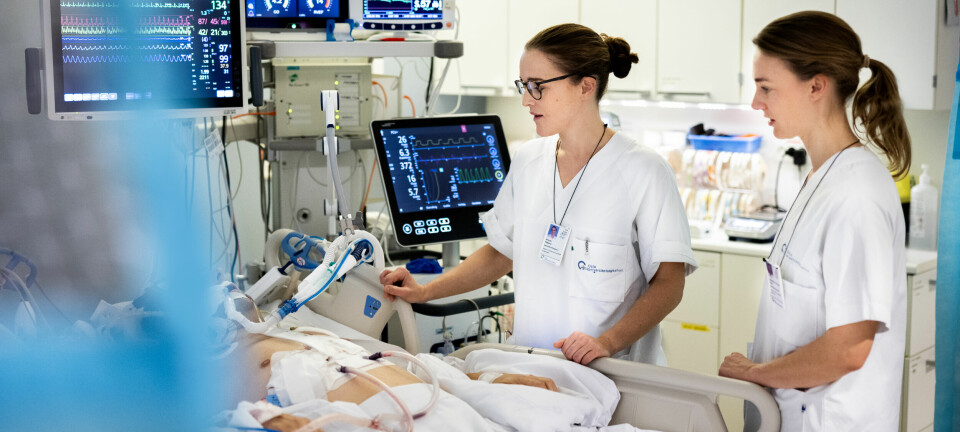No difference in functional outcomes between surgery and physiotherapy for symptomatic patients with a meniscal tear and knee osteoarthritis
Blikk på forskning i Fysioterapeuten 3/14.
Blikk på forskning utarbeides i samarbeid med Journal of Physiotherapy (Australia), som trykker forskningspresentasjonene under betegnelsen Critically appraised Papers, CAPs.
Synopsis
Summary of: Katz JN, et al (2013) Surgery versus physical therapy for a meniscal tear and osteoarthritis. N Engl J Med 368: 1675–1684. [Prepared by Kare B Hagen and Margreth Grotle, CAP Editors.]
Question: Does arthroscopic partial meniscectomy and postoperative physiotherapy result in better functional outcomes than standardised physiotherapy (PT) alone for symptomatic patients with a meniscal tear and knee osteoarthritis (OA)?
Design: A randomised, controlled trial in a 1:1 ratio with concealed allocation.
Setting: Seven US tertiary referral centres.
Participants: Men and women, aged 45+ years with a meniscal tear, mild to moderate OA, symptoms for at least four weeks, managed with medications, activity limitations, or PT. Exclusion criteria comprised having a chronically locked knee, severe OA (Kellgren-Lawrence Grade 4), inflammatory arthritis, or prior surgery to the affected knee. Randomisation of 351 participants allocated 171 to arthroscopic partial meniscectomy followed by PT and 177 to PT alone.
Interventions: Both groups received a similar PT program. The PT program was based on land-based, individualised physiotherapy with progressive home exercises. A phased structured program was designed to decrease inflammation, restore active joint range and neuromuscular re-education of quadriceps (Phase 1), restore muscle strength and endurance, re-establish full and pain-free active joint range, gradual return to functional activities, and minimise gait deviations (Phase 2), and enhance muscle strength and endurance, and return to sports/functional activities (Phase 3). It was recommended that the patient attend PT sessions once or twice weekly for six weeks and perform exercises at home. In addition, the surgery group had arthroscopic partial meniscectomy performed by trimming the damaged meniscus back to a stable rim followed by postoperative PT.
Outcome measures: The primary outcome was change in the physicalfunction scale of the Western Ontario and McMaster Universities (WOMAC) questionnaire from baseline to six months follow up. Secondary outcomes included the pain score on the Knee Injury and Osteoarthritis Outcome Scale (KOOS) and the physical-functioning scale of the 36-Item Short-Form Health Survey (SF-36).
Results: In total, 330 patients completed the six month follow-up. There was no difference between the groups in change in the WOMAC physical-function score (mean difference 2.4 points, 95% CI −1.8 to 6.5). There were also no significant differences between the groups in the KOOS pain score, SF-36 physical functioning, or frequencies of adverse events. At six months, 51 (30%) active participants in the study who were assigned to PT alone had undergone surgery, and nine patients assigned to surgery (6%) had not undergone surgery.
Conclusion: Patients with a meniscal tear and mild-to moderate OA who had arthroscopic partial meniscectomy with postoperative PT did not have better outcomes in functional status and pain at six months than those assigned to PT alone.
Commentary
Recent randomised controlled trials on conservative versus surgical treatment of knee injuries and knee osteoarthritis have indicated no beneficial effect of surgical treatment over physical therapy interventions (Frobell et al 2010, Kirkley et al 2008). In the present study, Katz and colleagues found that arthroscopic partial meniscectomy in combination with physiotherapy did not result in better functional outcomes than physiotherapy alone for patients with a symptomatic meniscal tear and knee osteoarthritis. However, 30% of the patients in the physiotherapy group crossed over to the surgery group within the six months follow-up. The authors of this study ask the important question whether patients with early degenerative changes in a symptomatic knee joint will benefit from surgery. Surgical treatment methods have been thought of as necessary for knee injuries, even though sparse high level evidence exists. This study shows that a period of physiotherapy of six weeks, with on average 8.4 physiotherapy visits, improved self-reported physical function with a similar clinical important difference as surgery. Even though 67% of the patients in the surgery group met the success criteria (defined in this study as 8 points improvement in self-reported physical function and not crossing over to the other group), 44% in the physiotherapy group also met the success criteria. This study shows that a period of physiotherapy should be performed in this patient group whether surgery is planned or not. A longer physiotherapy intervention may be suggested because a longer intervention may result in a greater treatment effect (Fransen et al 2009). Patients with symptomatic knees eager to return to high level activities or demanding work should go through a physiotherapy program with exercises targeting their activity of interest. Surgery is not inevitable for everybody with a meniscal tear, and surgery is always associated with risks. Importantly, despite a few concerns about the study design, the results from this study indicate that physiotherapy alone should be the first line treatment for all patients with a symptomatic mensical tear at the knee and mild to moderate OA.
Britt Elin Øiestad, Norwegian Research Center for Active Rehabilitation, Oslo University Hospital, Norway
References
Frobell RB et al (2010) N Engl J Med 363: 331–342.
Kirkley A et al (2008) N Engl J Med 359: 1097–1107.
Fransen M et al (2009) J Rheumatol 36: 1109–1117.
























